When you say terrier, most people think of the Jack Russel terrier. However, there are almost two dozen breeds that belong to the terrier group of dogs. A Dachshund Terrier mix can mean any number of things.
Size, coat length and color, and some temperament traits can be quite different from one terrier breed to another, so a Terrier Dachshund mix has many possibilities. In general, terrier-type dogs have many common traits, so we can somewhat predict what a Dachshund Terrier mix will be like.
You can never tell the exact features a mixed breed will have, but there are traits that are more established in a couple of mixes. We will mention seven terrier breeds that mix well with the Dachshund, so keep on reading.
Plenty Of Dachshund Terrier Mixes, But Which Ones Are The Best?
Terriers are known for their active lifestyles, rugged exterior, and barking-mad character. A Jack Russell terrier, Scottish terrier, Fox terrier, Cairn terrier, or Yorkshire terrier will be intense barkers, possess a strong prey drive, and require quite a lot of physical and mental stimulation.
On the other hand, terrier breeds such as the Boston terrier, Pit Bull terrier, and Rat terrier have less inclination to bark at everything. They might be better options for a Dachshund Terrier mix and families that want a dog that will bark less frequently.
All terrier breeds require moderate to high activity levels, so barking might not be the only demanding patience. Another thing to consider is the coat. All terriers are heavy shedders, and if mixed with a Dachshund, your chances of keeping the allergies under control will be low.
Despite all of this, the most popular mix is the Jack Russell Dachshund mix. Colloquially known as the Jackshund, this crossbreed is the most common dachshund terrier cross. I guess this means barking and shedding are not that important to people after all.
As a rule of thumb, the size of terrier parents is always small. This is because pairing a larger terrier breed with the Dachshund breed would end up in a comical catastrophe. To get a bit more serious and see what to expect from Dachshund Terrier mixes, let me introduce you to the candidates.
1. Jackshunds Are A Dachshund Jack Russell Mix
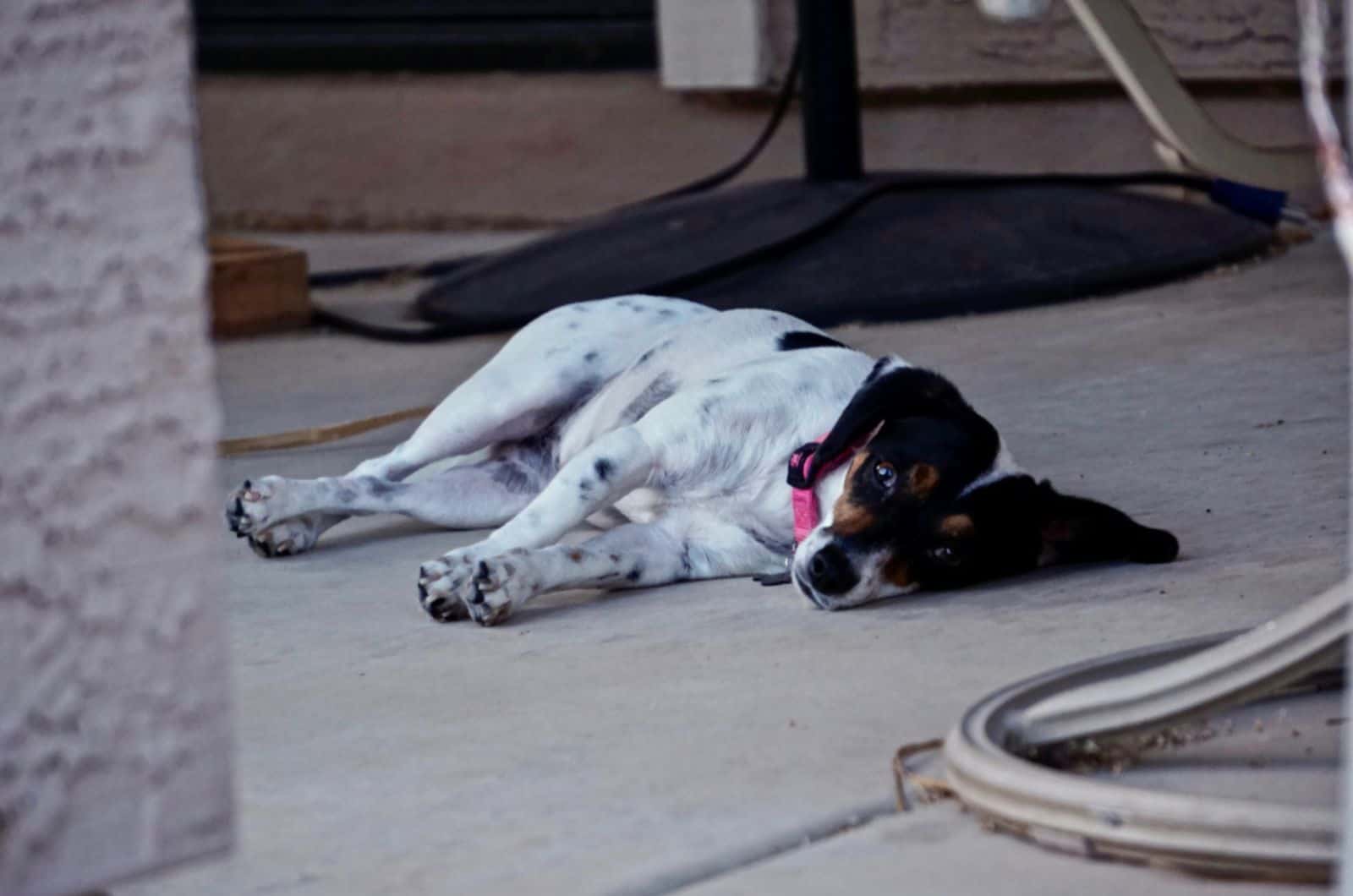
This mix is one of the most commonly talked about in the mixed breed world. With a height of eight to twelve inches and a weight of nine to twenty-eight pounds, this crossbreed is a small-sized dog.
The short legs are most frequently inherited from the Dachshund parent. The body frame is stocky, which means a strong neck and shoulders. A short muzzle, with a defined but not overpronounced stop, narrows towards the nose.
Jackshunds have moderately wide chests for their size, and the neck is muscular for easy navigation inside underground tunnels. Their back is straight and ends in a tail of medium length.
The long body is thanks to the sausage dog’s genetics, but due to the Jack Russell’s square frame, the Jackshund still looks stout rather than athletic. Hanging ears soften the overall tough build with a triangular shape.
Depending on which parent breed it inherited the tail from, it can be slightly longer or shorter, and its position when alert, if the Dachshund parent was dominant, will be level with the back. Jack Russell tails are erect with a slight bend at the top.
Coat, Colors, And Grooming
There are a few variations for the physical appearance of the Jackshund’s coat. Short and medium lengths, paired with the option of a smooth coat or wiry coat, open plenty of possibilities when it comes to coat quality.
While the Jack Russell terrier mainly has a white coat, the Dachshund parent will help the mix be more colorful with over a dozen colors. Most of them are breed standard and include different solids and patterns, such as black, cream, red, fawn, etc.
Grooming a Jackshund will be easy. Once or twice a week is more than enough, especially if your mix turns out to have a smooth coat. For the lengthier coat version, you will have to up your grooming game to three or four times a week.
Shedding potential is moderate to high with this cross. That is bad news for people who are allergic to dog hair and dander. Definitely consider a different mixed breed if you have severe symptoms.
More on Jack Russell coat and shedding in our Are Jack Russell Terriers Hypoallergenic? How Much They Shed? article.
Temperament And Socialization
In terms of temperament, this mix, more often than not, inherits the barking from the Terrier parent, so you are looking at a very talkative dog. Their energy levels and mental stimulation needs are moderate, but boredom can yield unwanted results.
They are great family dogs that are loyal, affectionate, and patient with kids but only moderately keen on living with other dogs. Jackshunds are welcoming of strangers, and their playfulness makes them have big expectations from the guests.
Do not mistake their friendly nature for naivety. Although on the smaller side, this mix is a decent watchdog. Their protective instincts are inherited from the Jack Russell side, but the Dachshund is no doozy slouch either.
Living with smaller animals, like hamsters or guinea pigs, will trigger their prey drive, so early socialization is key when cohabitation with this type of animal is not avoidable.
Also, make sure you spend enough time with the Jackshunds because they can become destructive if left alone for prolonged periods of time. Separation anxiety is not common in this mix, but it is better to take steps so that it is not even a possibility.
2. Get Dorky With The Yorkie And Doxie Mix, The Dorkie
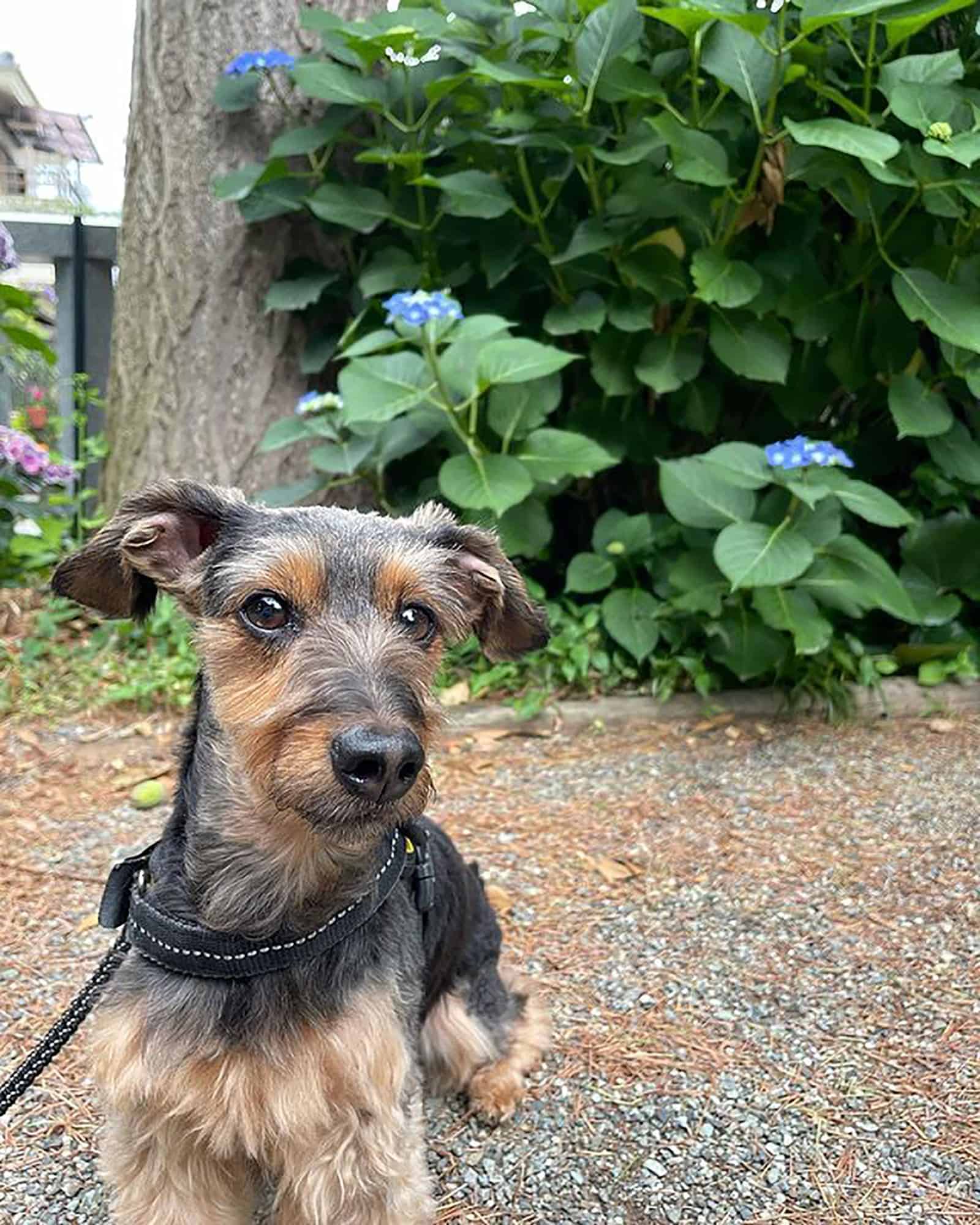
As a silky terrier breed, the Yorkie gives your Dachshund Terrier mix the possibility of a long silky coat. However, their long coat appears even longer on a seven to eighteen inches tall body, with a weight between seven and eighteen pounds.
This ratio of weight to height means the body frame will be more slender than the Doxie’s, but longer than the Yorkie parent. A pair of short legs always dominates in a Dorkie, meaning the cuteness will be taken care of.
The muzzle is short, and a clear dividing line between the muzzle root and forehead makes for a visible stop without being too prominent. The skull is on the narrower side, with a soft pointiness of the nose.
Both front and back legs are straight, without bending from shoulder to feet, and the chest is of low to moderate width. The eyes are well set in the eye sockets without any brow protrusion.
Like with most terrier mixes, the back is straight, and the tail is a continuation of it. When alert, the tail should be erect with a little curve unless docked as per terrier breed standards.
Coat, Colors, And Grooming
Known for its elegant long and silky coat, the Yorkie puts the posh in the Dorkie. The most common coat length is medium, but the texture can vary from smooth to silky. Terrier genes seem to dominate certain features, and the coat is often one of them.
So, a silky medium-length coat is likely. What about the colors? This Dachshund Terrier mix has a few options more than the Jack Russell mix. Black or blue solids with tan or gold secondary colors are added to the already rich color palette of the Dachshund.
Though grooming will require daily brushing thanks to the finer and longer coat, their low shedding potential might be a godsend for people that like the combination but do not want to intensify allergic reactions.
Since there is a chance of your Dorkie having a coat just like its Yorkshire terrier parent, you can check out our article about the Yorkie’s “hypoallergenic” coat properties.
Temperament And Socialization
You will notice that most of these mixes will be yappers. If that is something that does not bother you, then the Dorkie be a great family pet. Being smaller than most other terrier breeds, the Yorkie passes its lower exercise requirements to the Doxie.
A couple of moderately long walks a day should be enough for your Yorkie Doxie mix to spend most of its energy. Still, their playful nature dictates you have some fun too, so playing with guests and children can be considered the icing on the cake.
Doxies are highly adaptable and easily trainable. Whether you live in a house or apartment, it should be big enough to accommodate all the dog’s needs. Being pack animals that look to their leader (you) for guidance, they do not like being alone.
Protective instincts are strong in terrier mixes, no matter the size. As part of their hunting and extermination past career, they will bark at many things, including unknown sounds, scents, squirrels, foxes, etc.
Having a Dachshund Terrier mix puppy is not easy. It can get pretty scary and boring for a small dog that is on its own, so having an abundance of toys to keep them busy while you are away is crucial.
If you have other dogs, early socialization is key for establishing a good relationship between them. Tiny critter pets can be a source of fun for your Dorkie, so exposing them to your hamster early on can help you curb the dog’s prey drive.
3. A Dachshund Scottish Terrier Mix Is Rough Around The Edges

If you thought short legs were always a matter of Dachshund parent genes, you were wrong. The Scottish terrier has short legs but is pretty tall for a short guy. Reaching heights of eight to ten inches and weights of sixteen to twenty-five pounds make it a muscular small dog.
Unlike many other Dachshund terrier mixes, the Scottish terrier Doxie mix has a long muzzle with a barely visible stop. Its body is substantially longer than it is tall. Still, it retains a squarish silhouette due to the thick bones of the terrier parent.
The skull is narrow, with an almost equally wide muzzle. The ears have a chance to be erect and pointed or semi-erect with a softer triangular shape. In the rather rare case of upright ears, you can expect them to be fully upright at ten weeks of age.
With the square body shape comes the perfectly straight back that ends in a short to medium-length tail. It ends at a point and is usually at a forty-five-degree angle when alert. It can have a subtle bend in the last third of the tail length if the terrier gene is dominant.
Coat, Colors, And Grooming
Famous for their bushy brows and wise-man beard, some terrier breeds, like the Scottish terrier, pass that peculiarity on to the mixes. The Dachshund Scottish terrier mix usually sports a quality beard and rich eyebrows that extend over the eyes.
The coat in a Scotthund (improvised with this one) is usually medium-length, with the possibility of a double wiry coat. This gives plenty of styling options as long as you manually strip the weatherproof coat.
Most of these mixes have a wavy, medium-length coat. However, with the low odds of knowing what particular physical traits will be inherited from which parent, your puppy can get a fully smooth single coat from the Dachshund parent or a double wiry coat from the Scottish terrier.
In terms of coat color, you will have plenty of options that can include a great silver or black brindle pattern. Among other possibilities are fawn, red, and black as solids or with piebald, brindle, and other markings.
Grooming your Doxie Scottish terrier mix every other day will be enough to maintain proper hygiene, but keep in mind these dogs can have a wiry coats that can become tough to detangle if not cleaned and hand-stripped regularly.
Shedding levels are manageable, so you should not have many issues with hairs flying around, and allergy symptoms should be moderate at worst.
Temperament And Socialization
I have to say that the Dachshund Scottish terrier mix is pretty good for people who spend more time away from home. The Scotthund is an individualistic and self-sufficient crossbreed.
They can be stubborn dogs that prefer doing the basics right instead of desperately trying to obey their owner. Although not as trainable as some other Doxie terrier mixes, they are intelligent and playful.
Pronounced watchdog skills make it a decent family dog for people who want a rudimentary level of protection. The Scottish terrier Doxie mix likes its privacy, and strangers will not enjoy the same amount of love as from a Dorkie, for example.
Living with other dogs is not the ideal scenario for this mix, just like having small children around. This crossbreed will like having a purpose more than playing, but it is equally good for apartments and houses alike.
Prey drive could potentially cause stress to smaller animals you keep as pets in your home, so educate yourself on the possible ways of taming that prey drive. Socializing them with such animals and other dogs during puppyhood will save you a lot of trouble in the future.
4. Making Foxies With The Fox Terrier And Doxie Mix
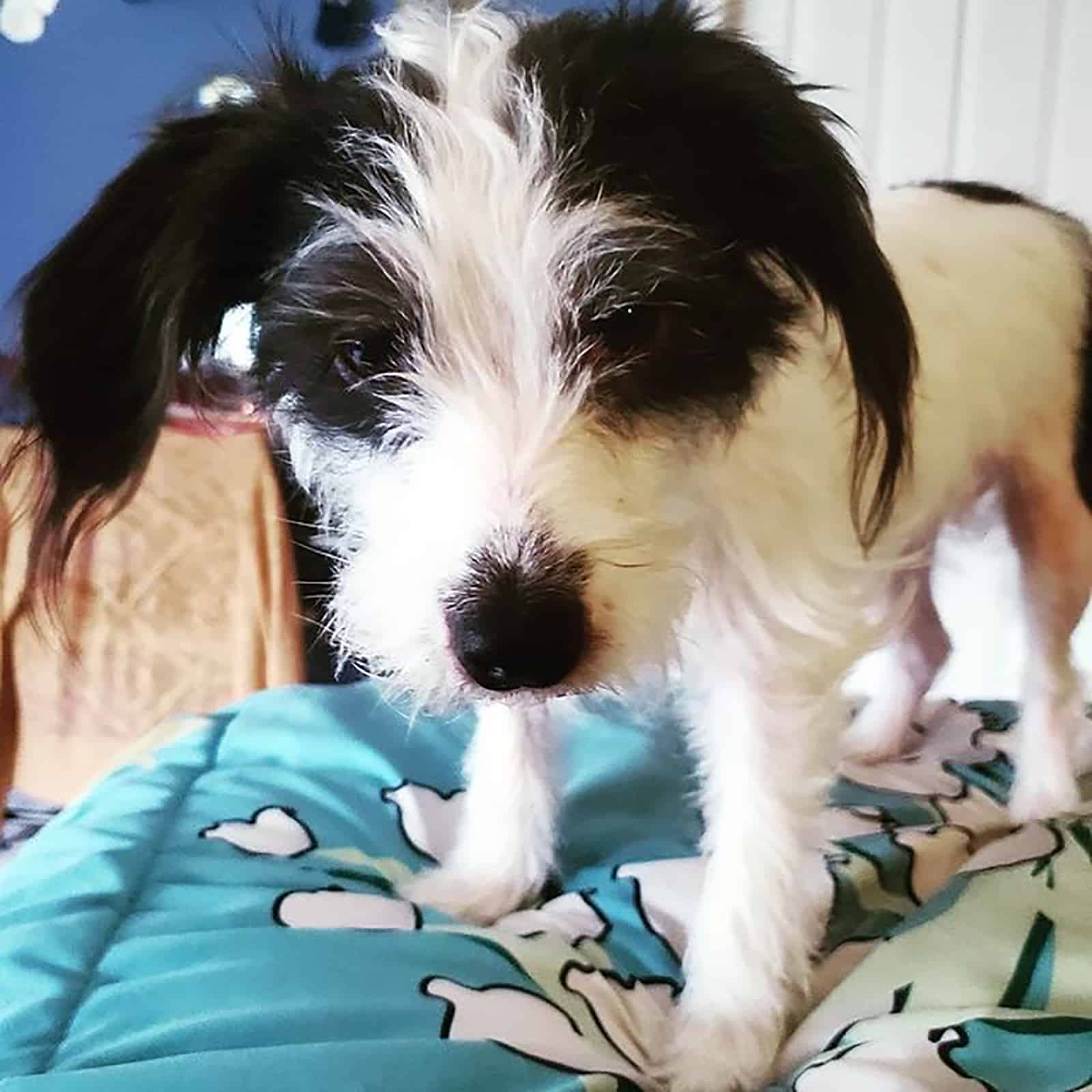
Foxies, as I like to call them, are beautiful dogs. Though there are Fox terrier Dachshund mixes that have short legs, the terrier parent seems to have more of a say in leg length.
At ten to fifteen and a half inches tall and around eighteen to twenty-five pounds heavy, the Foxie is a sizeable dog with a more athletic figure than other Dachshund Terrier mixes. Its muzzle is long and narrows toward the nose.
The narrow skull with semi-erect or floppy ears makes for a silly-looking face but still alert and intelligent expression. Thick bones and a broad chest make this mix very strong, with medium-sized feet that excel at digging.
Foxie tails have a slight curve in the fourth quarter and are almost upright when the dog is alert. Although, in most cases, the tail is of medium length, there are instances where the shorter pointy but otherwise thick tail of the Fox terrier is predominant in the mix.
Coat, Colors, And Grooming
Depending on whether the terrier parent has a smooth or wiry coat, the mix will have different possible outcomes. A wire Foxie will have a short to medium coat length with a potential double coat that is wiry.
Smooth Fox terriers are more common for crossbreeding with the Dachshund, so chances are you will have a smooth coat mix with a short coat. The wire Foxie will have a greater chance for bushy eyebrows and a beard, just like the Scotthund.
Similar to the Yorkshire terrier, the Fox terrier adds mostly white color to the mix. Theoretically, there is a chance that your Foxie will have a white coat. Chances are slim, though, and you are most likely going to have some combination of red, fawn, chocolate, or brindle with white.
Being moderate shedders, they are not the best choice for people with dog hair allergies, but they are very easy to groom. One or two brushing sessions per week will suffice for the smooth version, but the wire Foxie will be closer to daily grooming.
Temperament And Socialization
Arguably the best Dachshund terrier mix for families with small children, the Foxie really takes the crown here. They are very affectionate to their family with unmatched loyalty.
If the Fox terrier parent is a smooth Fox terrier, then it probably going to be a bit more reserved with strangers and be less patient with children. The wire Fox terrier is overall more laid-back, so the extra grooming is worth the tradeoff.
High trainability and adaptability make this mix very good for apartment living, but do not discard them as slouches. They are playful and have high-energy levels. Long walks complemented by obedience training are usually enough to tire them out.
Let us not forget that they are terriers, so frequent barking is a given. Regardless, they will best respond to positive reinforcement, while punishment will get them to become strong-headed.
5. Adding Presence To The Dachshund With The Boston Terrier
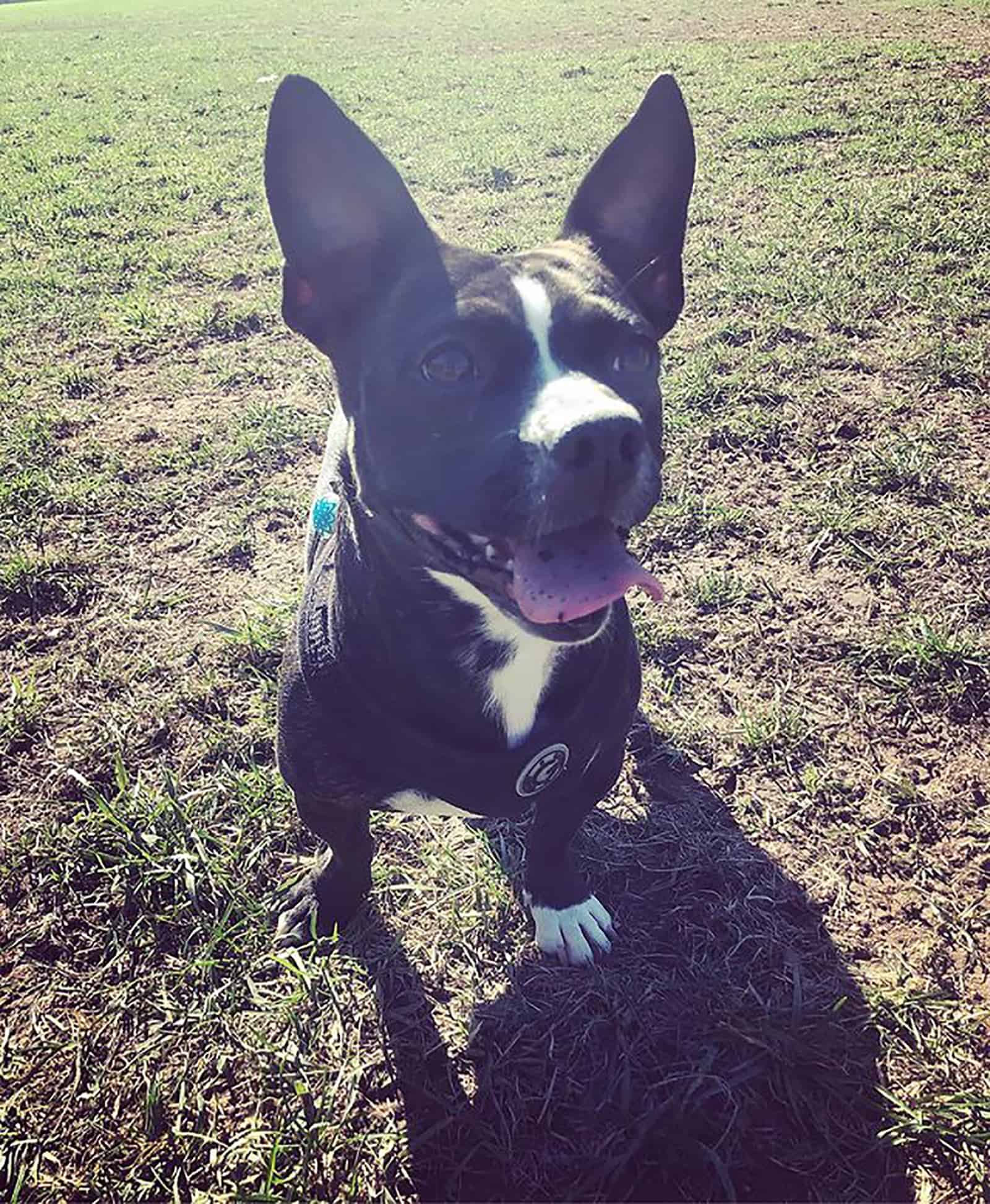
An excellent pairing to the sausage dog is a Boston terrier. Doxie and Boston Terriers have an athletic body frame that is squarish and quite tall at ten to seventeen inches. Their weight of fifteen to twenty-five pounds makes them as fit as a fiddle.
Dissimilar to the majority of terrier breeds, the Boston terrier’s square skull and short, almost brachycephalic muzzle are traits that the Doxie mix inherits too. Instead of a muzzle that is long and narrows to the nose, you have a short to medium one of considerable width.
The stop is abrupt, and the forehead is almost perpendicular to the root of the muzzle. The ears are usually semi-erect or hanging, but the pointiness and small size seem to translate more often than other features.
Having a broad chest is important when you are on work duty, so the mix features a well-developed ribcage and a thick, strong neck. Both front and hind legs are muscular without being disproportionate to the body.
A slight curve on the lower back is possible with the Doxie Boston terrier mix, and the tail has a chance of being a natural bobtail. This means that if the Bost Terrier parent was dominant in the tail department, your mix could have a naturally short tail that looks as if cropped.
Coat, Colors, And Grooming
Your Doxie Boston terrier mix will most definitely have a smooth coat of short or medium length. In most cases, the color will be a combination of the Boston terrier’s tuxedo coat and the Dachshund’s wide variety of colors.
Keep in mind that the predominant colors on the mix do not have to be a combination but are often completely inherited from one parent breed. That tuxedo color pattern does look nice.
Grooming is fairly easy. The occasional brushing will do the job, and shedding is not an issue with the Dachshund Boston terrier mix, with seasonal coat change the most “dangerous” period for all those with dog hair allergies.
If you want to know more about the Boston terrier’s coat and its effect on allergies, read our piece on whether this dog breed is hypoallergenic or not.
Temperament And Socialization
An athletic body requires intense exercise, and the Doxie Boston terrier mix is definitely an energetic dog. Long walks are great and all, but their playfulness and mental stimulation requirements have to be satisfied.
Thankfully, this mix is highly trainable and affectionate with its family, meaning you should have no issues teaching it to behave and do virtually anything you come up with.
Amazing with other dogs and patient with children, this mix is ideal for families with toddlers, other dogs, and people who like to entertain guests. The Dachshund Boston terrier mix thrives around people but does prefer a more active environment like a house with a larger yard.
The laid-back nature of this crossbreed is better for first-time owners than many of the other combos we’ve gone through simply because it barks less, reacts well to training, and is good with children and strangers. This is certainly a Boston terrier trait.
On the other hand, their calmer demeanor means you will have a better watchdog if you choose one of the previously mentioned terriers. Protective instincts are average at best with the Doxie Boston terrier.
6. Doxies And Rat Terriers Are A Match Made In Heaven
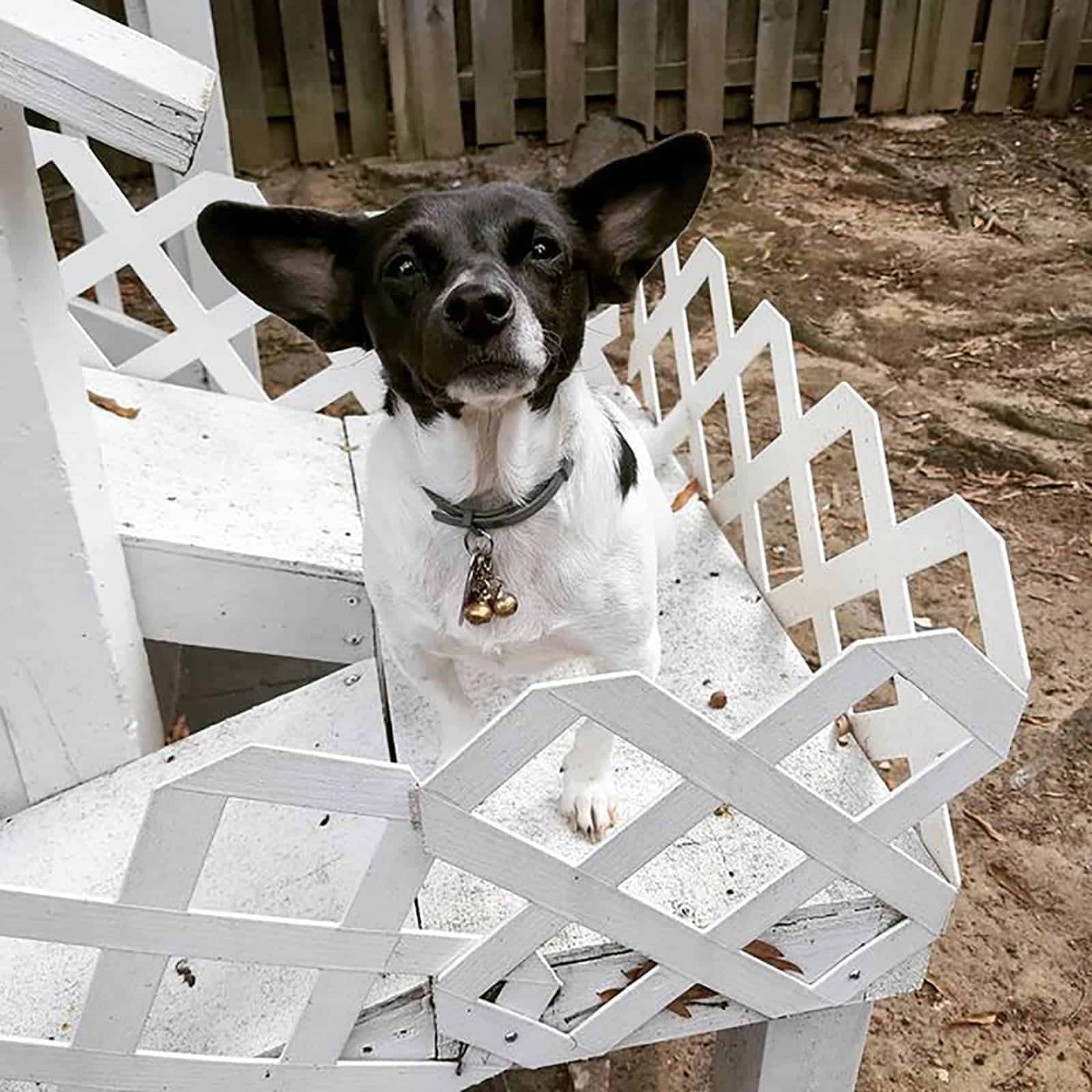
Though the name does put a stigma on this terrier breed, it is a magnificent worker dog. This mix is usually produced by crossbreeding a miniature rat terrier with a Doxie. That means that it will be between nine and twenty-two inches tall.
In terms of weight, the Ratsie is a slim dog that can be anywhere between twelve and twenty-eight pounds. Better described as athletic than stocky, the Ratsie has a narrow skull with a barely visible stop.
The pin nose means that it resembles a Pinscher, so the muzzle narrows towards the tip of the nostrils. Some brow bone protrusion is present but rarely visible enough to break the apparent jawline.
Pointy, semi-erect ears are a possibility, but Doxie Rat Terriers usually have floppy ears. The chest is narrower than in other Dachshund terrier mixes, and the body is clearly longer than its height. Legs are usually short but still longer than in the Dachshund.
Thinner bones mean faster movement, so the mighty rat-catcher x sausage dog mixed breed is ideal for running through doggy doors. The lower back is gently slanted, and it ends with a tail that is usually cropped unless the Rat terrier parent carried the bobtail gene.
Coat, Colors, And Grooming
Almost guaranteed is the short, smooth coat. Though there is not much to tell about the single-layer coat, the shedding is moderate. That means no “hypoallergenic” badge for the Ratsie.
Grooming this mix is a piece of cake. You brush it two times a week, and your Doxie Rat terrier will be as smooth as butter. Color combinations in the Ratsie are incredible.
You will get nearly every solid color option as an addition to white, plus the range of markings that include piebald, Irish white, badger markings, blanket back, etc.
Temperament And Socialization
Despite other dogs being an ok proposition for the Ratsie, the family, especially children, will enjoy its affectionate displays of playfulness. Asking the guests to play fetch will be a primary concern for it, so make sure there are plenty of toys around.
A brave heart does not require a large body to be protective of its family and territory. A Highly-trainable and active dog, the Rat terrier Doxie mix will be ideal for families who live in houses with large yards or even acres of space to speed around.
Still, you will have no problems with their adaptability. Longer walks with some structured training routines will do wonders for the Dachshund Rat terrier mix, and you will be able to enjoy relaxing evenings once all that energy is gone.
Barking in moderation, this crossbreed likes to be close to its humans, so make sure you have ways of entertaining it while away from home. You can rest assured that your belongings will be well protected, as the watchdog potential is pretty high with the Ratsie.
Common Health Issues In Dachshund Terrier Mixes
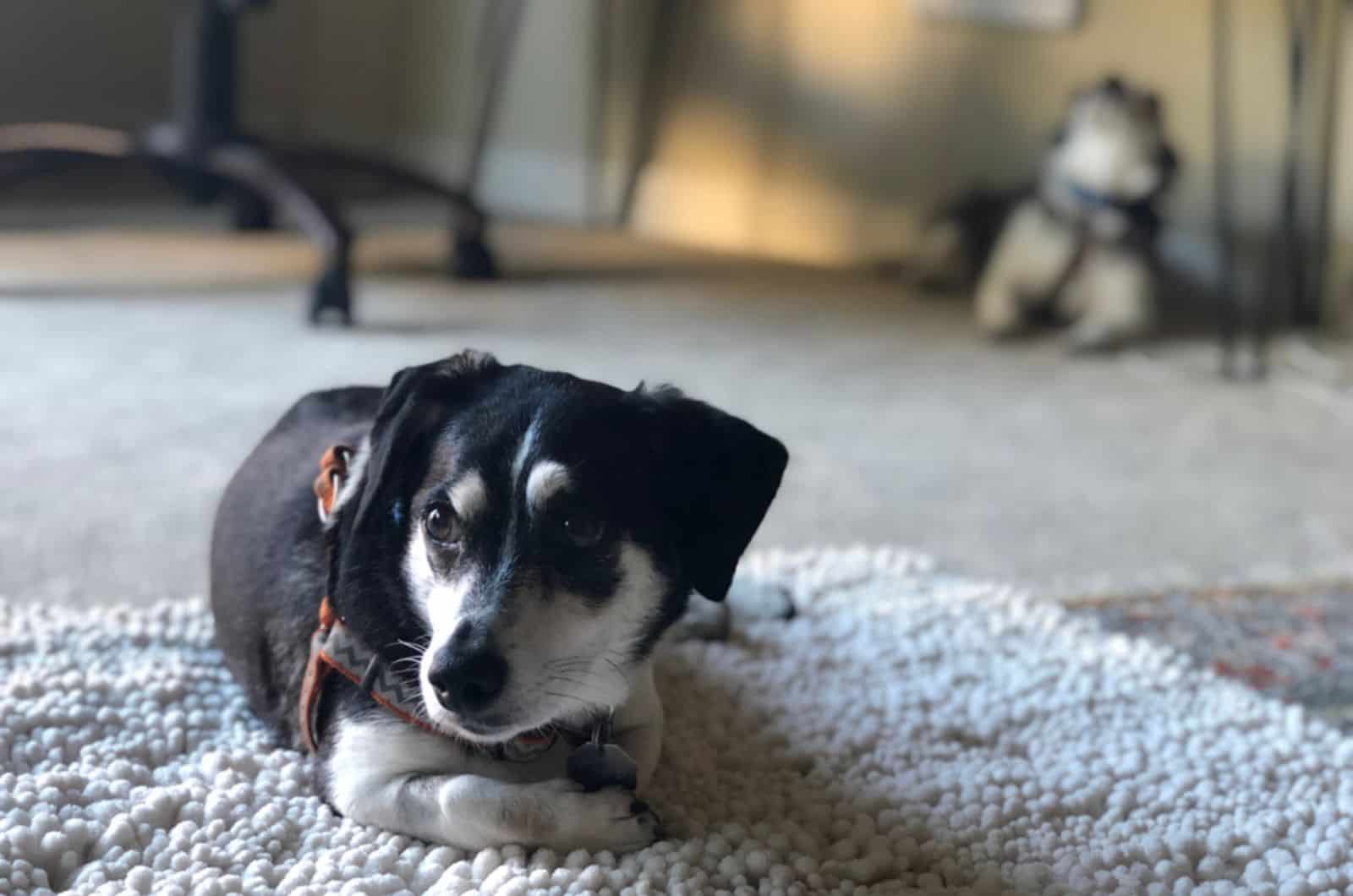
Every crossbreed, the Dachshund Terrier mix not excluded, is prone to some genetic diseases that make life tougher for both owners and dogs.
Your pooch will thank you for knowing about these ahead of time so that you can give it the best life possible without ever needing to worry about health problems. A heads-up is necessary for one particular condition that many dog owners neglect, so let me start with that one.
Obesity
Dog food can be a tricky thing to get if your dog has a small body with a big appetite. Most of these mixes are very active, but in periods of the year when outdoor activity is reduced, such as winter, those calories can be tough to burn.
This is why obesity is one of the leading dog health issues. If your dog is slightly overweight, that can be managed by reducing the calorie intake, but if it becomes obese, it will be prone to other health conditions like diabetes mellitus, hypothyroidism, and hip and elbow dysplasia.
Many secondary health problems appearing due to obesity are also congenital, so it is best not to take your chances by increasing the risk of your dog having one of them.
Proper nutritional balance with high-protein and low-carb diets will be enough to curb obesity. Increasing exercise intensity is always better, but keep in mind treats should be counted in the daily caloric limits too.
Intervertebral Disc Disease (IVDD)
Intervertebral disk disease is a very common occurrence in dogs that have a body significantly longer than its height paired with short legs. Of course, the Dachshund is that breed of dog, and even the Scottish terrier has shorties.
When the spinal cord is compressed due to activity, or in this case, anatomy, the little gelatinous protective structures that shield the nerve from damage protrude or extrude. This puts pressure on the nerve, causing pain, loss of sensation, or even paralysis of nearby limbs and organs.
The most common symptoms include limping, irregular gait, and dragging the leg. Pain meds and complete rest are the usual therapy, but severe cases where symptoms include the inability to move or paralysis are candidates for surgery.
Eye Problems
Conditions affecting the eye frequently plague smaller designer breeds such as the Dachshund Terrier mix. The vast majority of them are congenital, so genetics is the main problem.
- Hereditary lens luxation is associated with anatomical anomalies that cause the retina to detach from the posterior eye structures. There are two types of lens luxation: anterior and posterior. The former affects the front part of the eye, and the latter the back of the eye.
Anterior lens luxation is much more dangerous and usually has more severe symptoms such as eye redness, bulging eyes, etc., and the only treatment is surgical reattachment of the retina.
- Glaucoma can often occur as a complication after anterior lens luxation and is defined as an increase in intraocular pressure. A detached retina can also happen due to glaucoma and the eye fluid not draining properly, thus putting pressure on the front eye structures.
Symptoms are usually eye redness, opaque appearance, slow-reacting pupils, reduced tear production, etc. Treatment includes medication and surgery for more severe cases.
- Cataracts are wandering proteins that are a normal part of the eye. When they start grouping, the dog’s vision and the transparent part of the eye will become cloudy. Routine surgery is commonly performed on dogs with cataracts.
Diabetic dogs are a high-risk group for cataracts, so make sure you feed your dog a proper diet to lower the chances of this condition. Symptoms include spotty eyes, redness, cloudy retina, etc.
Dachshund Terrier Mix Lifespan
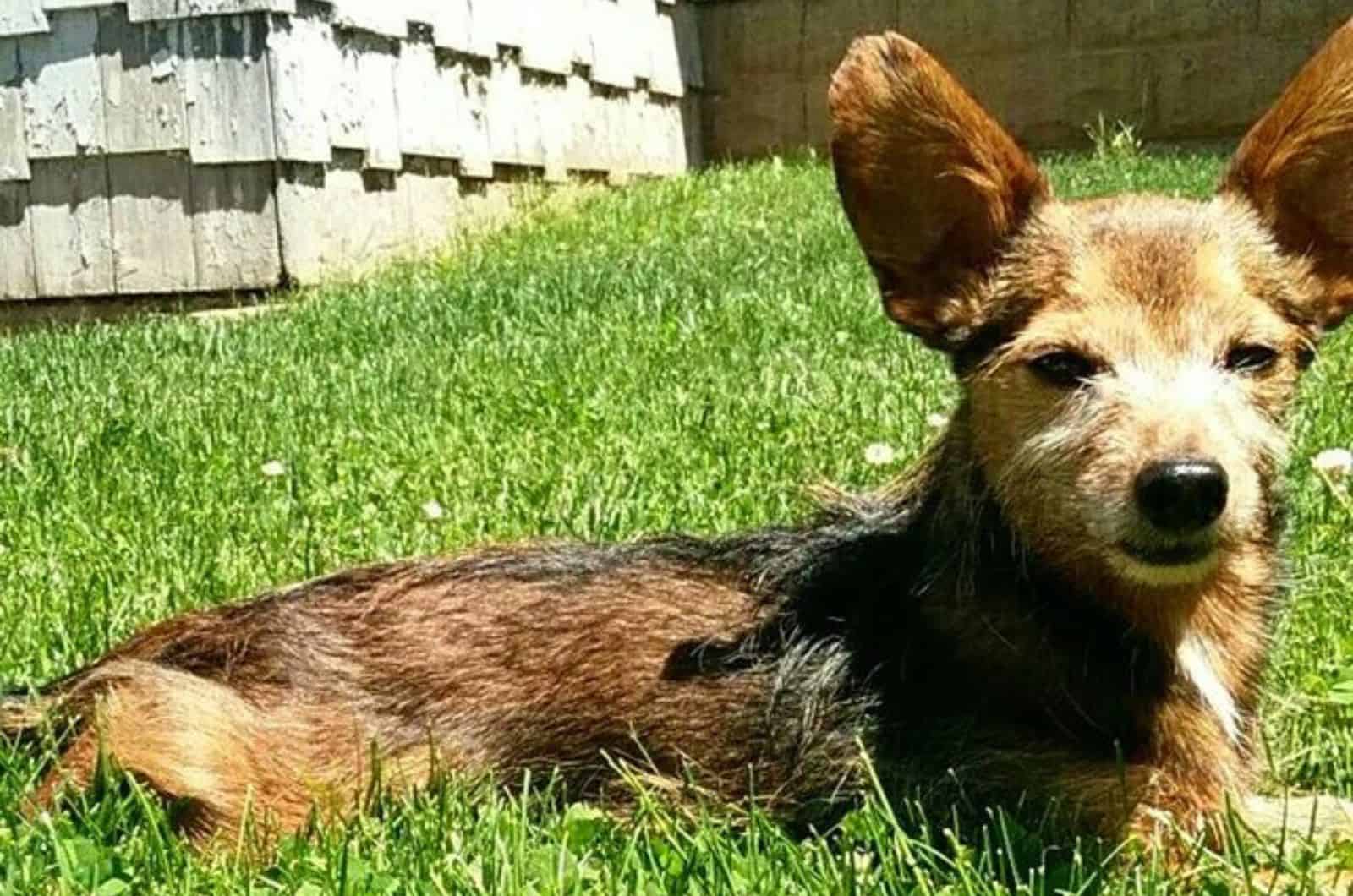
The purebred parent breeds of the Dachshund Terrier mix are very healthy, sturdy little dogs. A lot of the story on life expectancy depends on breeder choice.
If you chose a breeder who does not have any health certificates of the parent breeds, then chances are they have genetic diseases that will probably be inherited by your mix puppy.
While the previously mentioned health issues are the most common, there are other genetic conditions that can affect your mix. Thankfully, there are genetic tests for dogs that show the presence or determine the likeliness of those hereditary conditions.
So, how long is the Dachshund Terrier mix going to live? On average, between eleven and sixteen years. Thanks to some lengthy lifespans from the parent breeds, you will almost have a decade and a half to hang out with your canine friend, provided you take great care of it.
Conclusion
While theoretically, any two dogs can be crossbred, the Dachshund Terrier mix works best with the combinations we went through. Some Dachshund mixes are simply unethical, with a greater chance of health problems.
The Pit Bull terrier mix, for example, would cause so many problems for the dog due to the size differences, unproportionate body size to the short legs, and many more things that would only create difficulties for your dog.
Plenty of the mixes we mentioned, and some other, less popular ones, are great for all types of owners and families. Low-barking, high-barking, laid-back, or hyperactive, there is a Doxie Terrier mix for everybody.
No matter the crossbreed, the best dog is the one you get in the end. I hope this article swayed you towards one or two of the best mixes.















